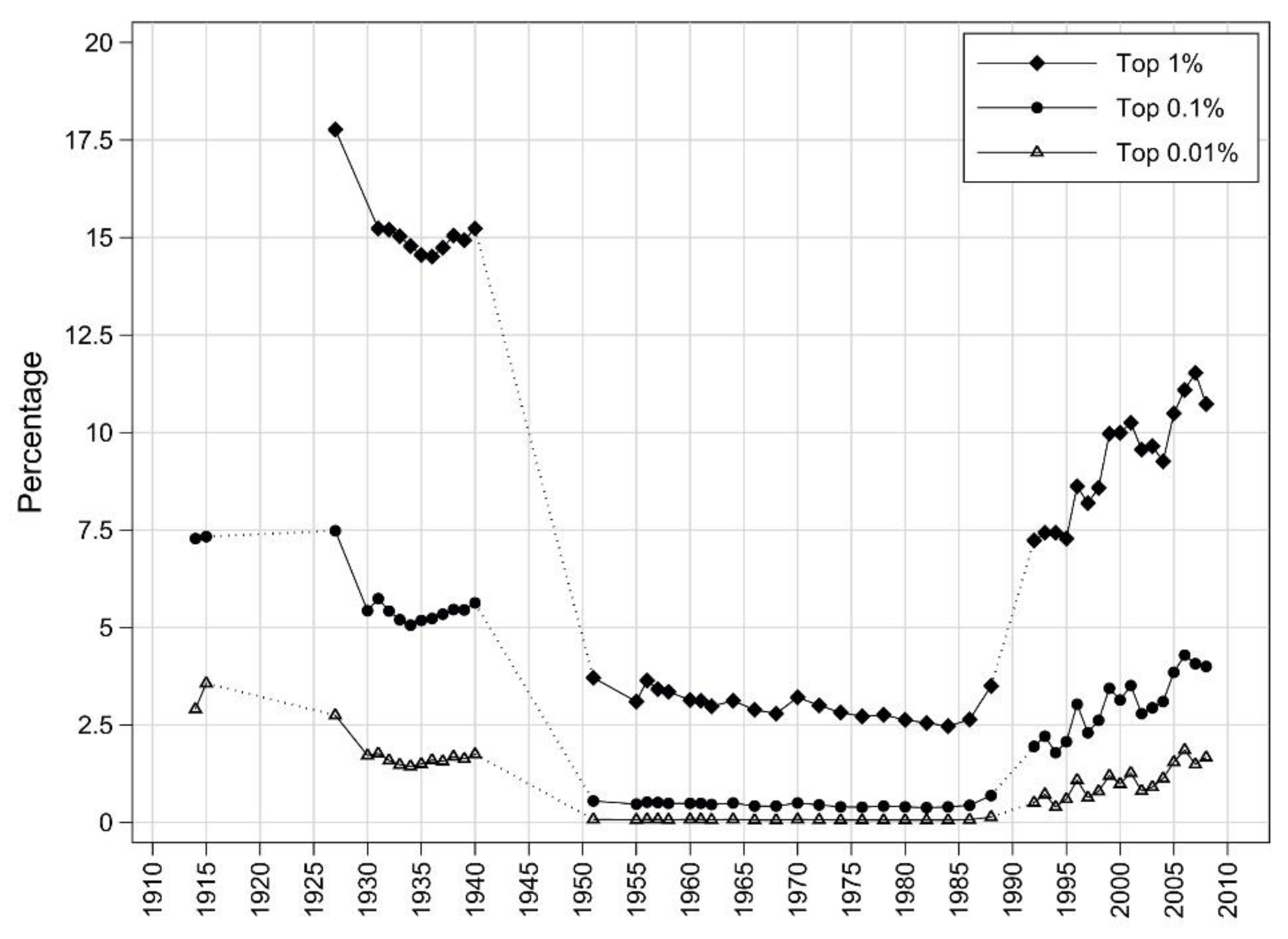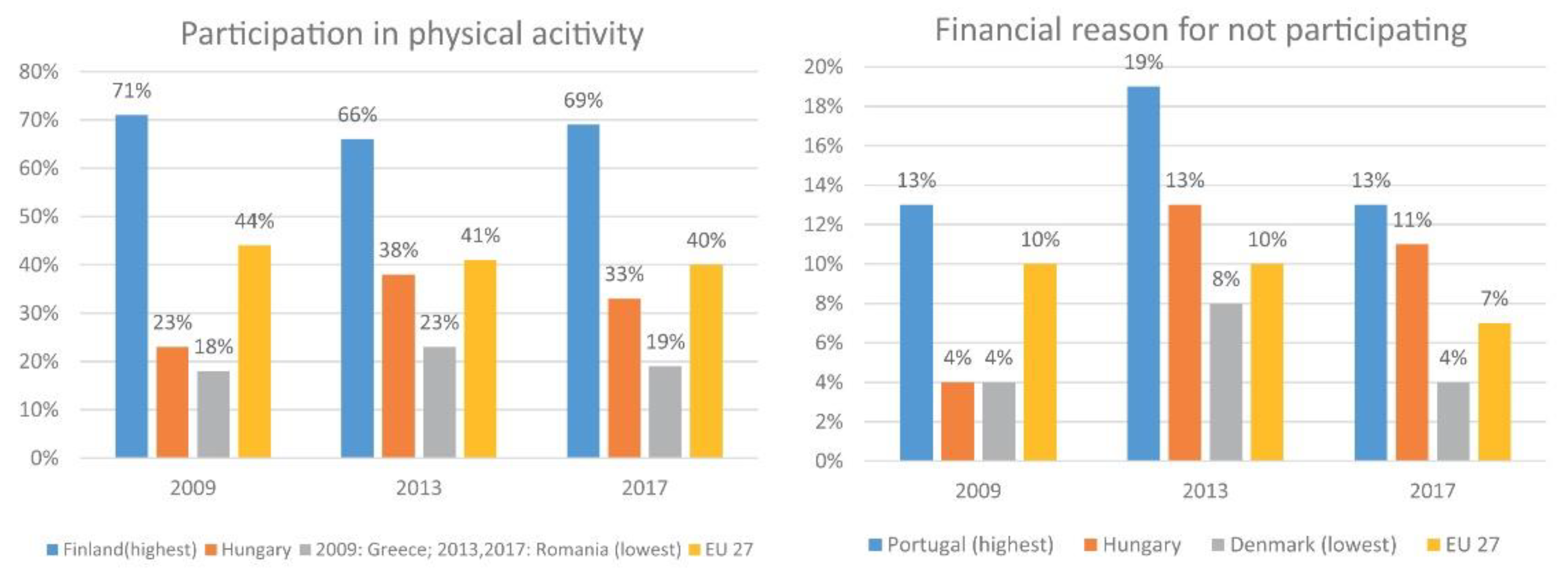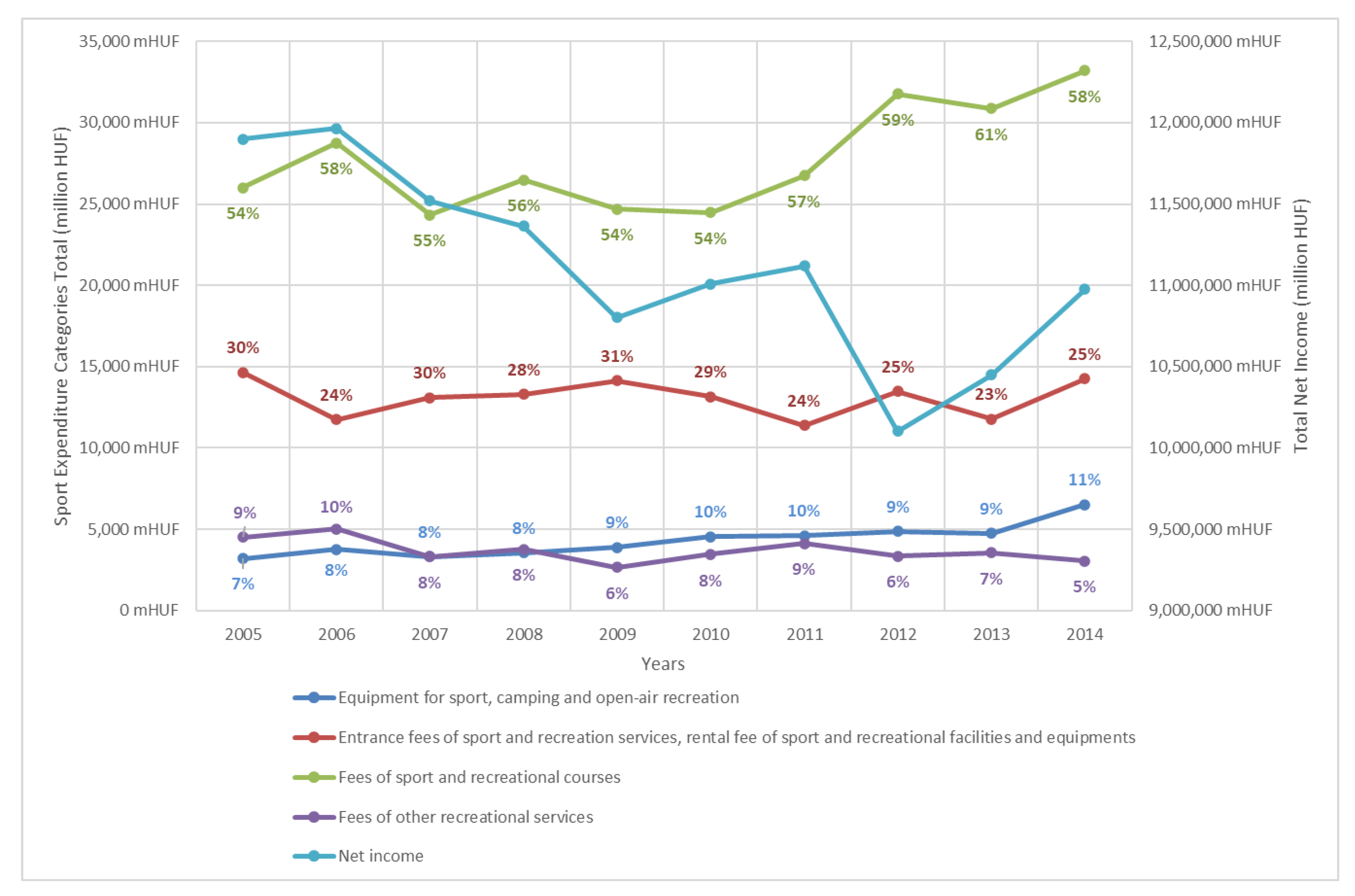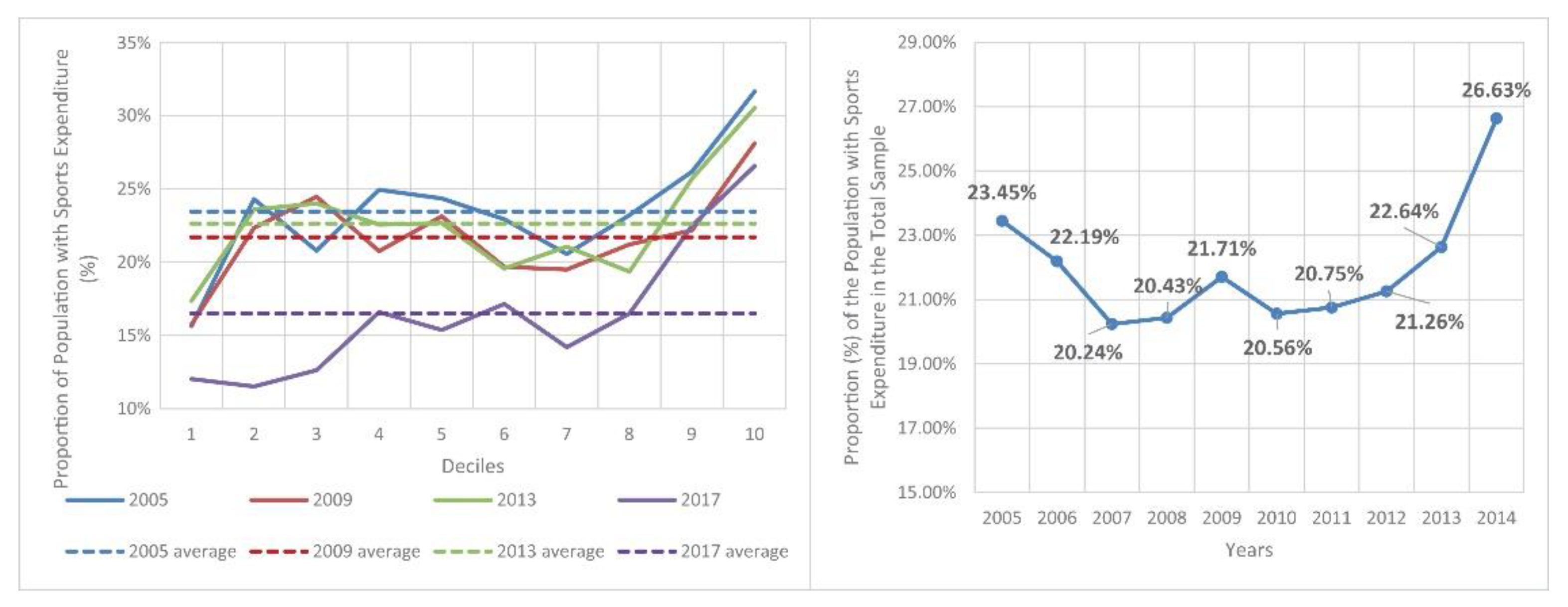2. Materials and Methods
The database forming the basis of the analysis was the annual Household Budget Survey (HBS) collected by the Hungarian Central Statistical Office (HCSO), based on a stratified, multi-stage sampling methodology, in the 2005–2017 period. HBSs are nationally representative with regards to Hungarian private households. The sample sizes for each year are summarized in
Appendix A,
Table A1. The database contains weights for each responding household, which indicate how many other households are represented nationally by the responding household. This makes it possible to aggregate specific income and expenditure categories.
HBSs use the Classification of Individual Consumption by Purpose (COICOP) nomenclature, based on Eurostat methodological recommendations. There was a methodological change in data collection in 2015, which limits time series comparisons of sports expenditure items, but not inequality indicators. Our research makes use of the income and sports expenditure items (related to both active and passive sports consumption) listed in
Table 1. Sports expenditures were aggregated into an aggregate indicator.
Table 1 also contains the consumer price indices used by the CSO to convert these items to inflation adjusted value in 2017.
The household level data was calculated per capita, using household size, as also recorded by the HBS. Income deciles determined on the basis of net income per capita were used to analyze inequalities.
The weighted net incomes and sports expenditure items of households was aggregated. Averages for the total sample size, as well as for income deciles per each year, were also calculated. In addition to the full sample database, the averages were calculated separately for a sub-sample of households for sports expenditures.
The following indicators based on the share of each income decile in the total sample were calculated to demonstrate inequalities:
Gini coefficient;
normalized Herfindahl-Hirschmann Index;
Robin-Hood Index;
ratio of the highest and lowest income decile aggregate values (Q10);
ratio of the highest and lowest income quintile aggregate values (Q5).
The relationship between income and sports expenditure inequalities was examined using the correlation coefficient.
The cross-sectional data is presented for the first year of the time series (2005) and for the years 2009, 2013, and 2017, in which years the representative Eurobarometer surveys on non-professional sports behaviour were carried out [
32,
33,
34].
4. Discussion
Several studies have shown that, the higher an individual’s income, the more likely they are to spend on sports, whether active or passive [
41,
46,
47]. In addition, some studies have argued that sports can be seen as a luxury good [
39,
40,
48]. For Hungary, a cross-sectional analysis of sports expenditure by income quintiles has already been carried out [
39], but no cross-sectional or time-series analysis for income deciles.
Based on the results of the present research, there are two distinct phases in the income trend of Hungarian households in the period examined: aggregate income declined between 2005 and 2012 and then started to increase again between 2013 and 2017. The same dichotomy can be observed at the level of deciles, except for the top and bottom deciles. The top decile started to see an increase in real income by 2009, much earlier than the other deciles, while the bottom decile only started to reverse the trend by 2016. The top income decile returned to the 2005 base income level by 2013, while the other income deciles reached that level by 2015–2017. At the same time, the bottom income decile still had not returned to 2005 real income levels by 2017.
Deciles 8, 9 and 10 were able to perform above the average real income level of the general population, while the average income of all other deciles was below this level during the period under review. Narrowing down the sample to households with sport expenditures in each year, average per capita incomes were found to be higher for this sub-sample relative to the entire population. However, significant differences between the complete sample and the sub-sample with sport expenditures were found only for the bottom and top income deciles, typically in favor of households spending on sports.
The bottom and top income deciles diverged upwards and downwards respectively in income relative to the other deciles. The deterioration in living standards affected the bottom income deciles for much longer and to a greater extent than the top deciles. All the income inequality indicators show increasing income concentration between 2005 and 2017, which confirms the polarization of income in Hungary [
49,
50]. This suggests that wealthy households were in a more favourable position in terms of sports expenditure during the researched period.
Aggregate sports expenditure on “equipment for sports, camping and open-air recreation”, as well as “fees for sports and recreational courses”, showed an increase between 2005 and 2014. The first one doubled, although its share in total sports expenditure remained between 7–11%. The second one increased by around 27%, but in absolute terms this represents an increase of more than 7 billion HUF, as it is also the largest share of sport expenditure, at between 54% and 61%. These two items are also those most directly related to participation in active sport, which can be compared with Eurobarometer data (see later) [
32,
33,
34].
Averages of sports expenditure per capita show a steady increase towards the upper-income deciles, accelerating from income deciles 6 and 7. As was observed for real per capita income, the 9th and 10th deciles are those with average sports expenditure values higher than the averages of the total samples for each year.
The proportion of people with sports expenditures in the total population fluctuated between 20.24% and 26.63%. This proportion, much like the income situation, showed a downward trend until 2007 and an upward trend from 2007 onwards.
In the years examined, 2005, 2009 and 2013, there was a particularly low proportion of people with sports expenditures in the bottom income decile, roughly an average for deciles 2–9, but the top decile showed an outstanding proportion. This shows that, apart from the two bottom deciles, sports played a part in the lives of almost the same proportion for most of the population in these years. By contrast, there was a more pronounced polarization in 2017, as the first three deciles showed a significant gap compared to the others, while rates in the top two deciles were at the same level as in the other three years, even though all the other deciles had worse rates in this particular year.
As about a quarter or a fifth of the Hungarian population had sports expenditures, there was a significant difference between the total sample and the sub-sample with sports expenditures, in real terms of sports expenditures for each year.
The proportion of people with sports expenditures implies that the top two deciles continued to be in a better situation than the average of the whole sample, both in the case of income and sports expenditure.
Inequalities in sports expenditure within the population have shown an increasing trend for all inequality indicators in the observed period, although some fluctuations can be found in the data. The correlation of sports expenditure and income inequality indicators confirms that income conditions move together significantly with the level of sports expenditure and that income polarization also correlates to polarization in sports expenditure.
Hungary has been spending a significant share of its central budget on sports as a proportion of GDP in a European comparison since 2014 (
Figure 8). In addition, the redirection of government corporate tax revenues into the sports sector has also led to a significant inflow of resources since 2011. The increasing trend in government and household sports expenditures can be compared with active and passive sports consumption data.
The proportion of people participating in active sports at least once per week in the EU stagnated between 2009 and 2017. An improvement could be observed in Hungary between 2009 and 2013 but this indicator has tended to stagnate since then [
32,
33,
34]. Financial reasons as a barrier to participation in sports were highly significant in public opinion surveys in 2013 and 2017 [
32,
34]. Data from the EU SILC [
31] database indicate that there are much larger differences in the willingness to participate in sports among the income quintiles in Hungary than the EU average. This is in line with the findings of Paár [
39], Paár et al. [
52] and Laczkó et al. [
53] that higher income and social status also lead to higher sports expenditure and a higher likelihood of sports participation. At the same time, the sporting activity of a country’s inhabitants depends not only on socio-economic determinants but also on their (sports)cultural background and habits. Therefore, a significant increase in public spending on sports alone does not necessarily lead to an immediate improvement in sports participation and spending. This can only be hoped for if the focus of sports policy goes beyond improving access to encouraging a change in public attitudes.
While time series data are not available for passive sports consumption, cross-sectional data from 2015 shows that Hungary is slightly worse than the European average, while the related aggregate sports expenditure items show stagnation in our study period.
The growing income inequality in Hungary can be seen as a natural consequence of the capitalist market economy, as income inequality indicators have been steadily increasing in the former socialist bloc countries, but still lag vis-à-vis the traditional capitalist countries. Western European countries not only have higher living standards (life expectancy, disposable income, sports expenditure, etc.), but also higher income inequality [
27,
35,
36].
Increasing income inequality is undesirable for several reasons: (1) it can lead to a deterioration in subjective health through the subjective perception of the relative social position of individuals [
54], (2) it leads to inequalities in consumption [
21], and (3) it undermines social stability [
2,
19]. (4) Increasing income inequalities may also prevent access to sporting opportunities for broader segments of society [
38]. The observed increase in inequalities in sports consumption in the current research is also associated with an increase in income inequality. This can be assessed as a negative trend, as it can negatively affect several health indicators through multiple transmission mechanisms [
24,
25,
26].
The main limitation of the current research is that the sports expenditure data collected by the HCSO based on COICOP categories do not correspond exactly to active and passive sports consumption activities. A more detailed breakdown of these categories would be desirable in the future. It is also difficult to carry out a full analysis of sports expenditure because a number of items related to either active (sports clothing, sports footwear, expenditure related to school sport, etc.) or passive (consumption of sports media, etc.) sports consumption cannot be precisely identified, or are included in other main categories of the COICOP classification, together with other irrelevant items. These could not be objectively included in the analysis.
An important limitation which restricts the comparison of expenditure data during the whole examined period is the methodological change in the data collection in 2015.
It would also provide valuable insights if income and sports expenditure data on inequalities could be compared with time spent on sports consumption, but the HBS does not collect time-use data.





















